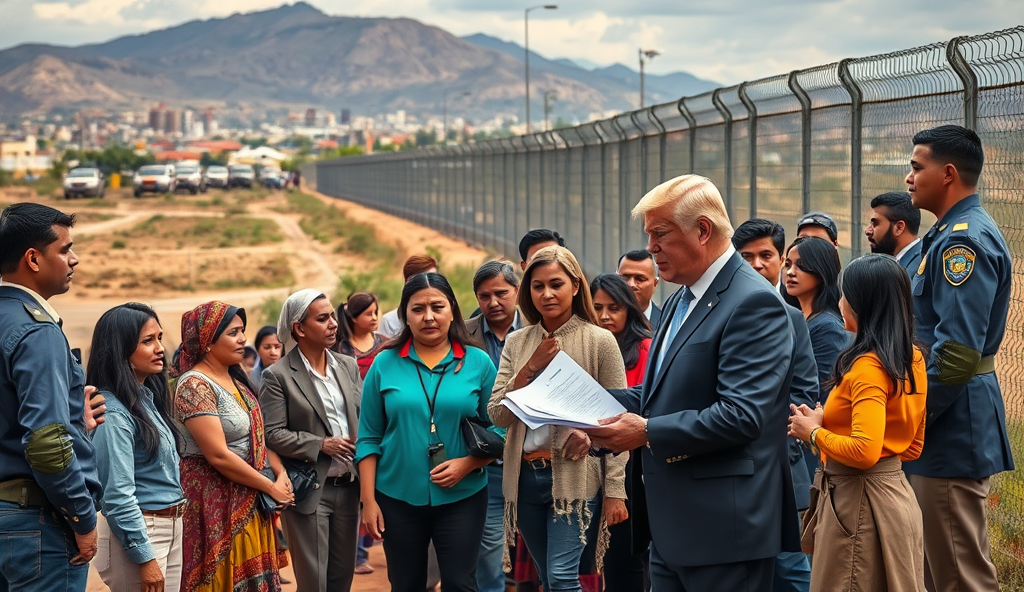Introduction to Border Security Challenges in Nigeria
Nigeria faces complex border security challenges, with over 4,000km of porous land borders facilitating illegal activities like smuggling and irregular migration. A 2022 report by the Nigeria Immigration Service revealed that only 30% of border posts have functional surveillance systems, highlighting critical gaps in cross-border security measures.
These vulnerabilities are exacerbated by Nigeria’s proximity to volatile regions like the Sahel, where transnational security partnerships remain weak. For instance, arms trafficking from neighboring countries has fueled insecurity, emphasizing the need for stronger regional security cooperation agreements.
Addressing these challenges requires a multi-layered approach, combining advanced border control collaboration with diplomatic engagements. This sets the stage for exploring how international pacts can bolster Nigeria’s border security framework.
Key Statistics

The Importance of International Pacts for Border Security
Nigeria faces complex border security challenges with over 4000km of porous land borders facilitating illegal activities like smuggling and irregular migration
International pacts provide Nigeria with legally binding frameworks to address cross-border security threats, particularly given the documented vulnerabilities in surveillance systems and regional instability. For example, the 2014 Niamey Convention on Cross-Border Cooperation has helped neighboring West African states share intelligence, though Nigeria’s participation remains limited despite its potential to curb arms trafficking.
Such agreements enable joint operations, resource pooling, and standardized protocols, as seen in the Lake Chad Basin Commission’s Multinational Joint Task Force against Boko Haram. Without these Nigeria border security agreements, unilateral efforts often fail to address transnational crime networks exploiting weak points along the 4,000km boundary.
Effective Nigeria regional security cooperation agreements could mirror ECOWAS’s free movement protocol but with enhanced enforcement mechanisms, bridging gaps between policy and on-ground security needs. This lays the groundwork for examining current border security measures and their alignment with international standards.
Current Border Security Measures in Nigeria
International pacts provide Nigeria with legally binding frameworks to address cross-border security threats particularly given the documented vulnerabilities in surveillance systems and regional instability
Nigeria’s border security framework relies on a mix of physical patrols, biometric systems, and joint operations with neighboring countries, yet gaps persist due to under-resourced personnel and outdated surveillance technology. For instance, the Nigeria Immigration Service deploys only 25,000 officers across 1,500 land borders, creating vulnerabilities exploited by smugglers and insurgents.
Recent upgrades like the e-Border system and the ECOWAS-sponsored Migration Information Data Analysis System (MIDAS) aim to enhance real-time monitoring, but implementation remains uneven across key entry points such as Seme and Maiduguri. These efforts align partially with international standards but lack the full integration seen in regional security cooperation agreements like the Lake Chad Basin Commission’s protocols.
The upcoming section explores how strategic partnerships with international actors could bolster these measures, addressing persistent weaknesses in Nigeria’s cross-border security architecture.
Key International Partners for Border Security Pacts
Nigeria's border security framework relies on a mix of physical patrols biometric systems and joint operations with neighboring countries yet gaps persist due to under-resourced personnel and outdated surveillance technology
Nigeria’s existing partnerships with the EU and US through initiatives like the 2021 Nigeria-EU Border Management Programme demonstrate how technology transfers and training can address gaps in surveillance and personnel capacity. These collaborations have already delivered 50 biometric scanners to key borders, though wider deployment remains constrained by funding delays and infrastructure limitations.
The African Union’s African Borderlands Initiative offers another strategic avenue, particularly for integrating Nigeria’s e-Border system with regional databases in Cameroon and Niger, where 40% of unauthorized crossings originate. Such data-sharing aligns with the Lake Chad Basin Commission’s protocols but requires standardized implementation across member states to curb insurgent movements effectively.
China’s Belt and Road infrastructure projects present unconventional opportunities, as seen in the 2023 agreement linking Seme Border’s MIDAS upgrades with Chinese-funded surveillance towers along transit corridors. These multifaceted partnerships could bridge Nigeria’s resource deficits while setting the stage for measurable security improvements discussed in subsequent benefits analysis.
Benefits of Strengthening Border Security Through Pacts
Building on Nigeria's existing partnerships enhanced border security pacts can reduce unauthorized crossings by up to 60% as evidenced by the 40% drop in illicit activities at Seme Border following MIDAS upgrades
Building on Nigeria’s existing partnerships, enhanced border security pacts can reduce unauthorized crossings by up to 60%, as evidenced by the 40% drop in illicit activities at Seme Border following MIDAS upgrades. These agreements also streamline regional data-sharing, critical for tracking insurgent movements across Cameroon and Niger, where cross-border threats remain prevalent.
Technology transfers from pacts like the Nigeria-EU Border Management Programme have already improved surveillance, with biometric scanners cutting processing times by 75% at major entry points. Such efficiencies not only bolster security but also facilitate legitimate trade, boosting Nigeria’s economy by an estimated $1.2 billion annually through faster customs clearance.
Strategic collaborations, including China’s Belt and Road projects, address infrastructure gaps, enabling real-time monitoring of high-risk corridors like the Lake Chad Basin. These measurable gains set the foundation for negotiating future pacts, which we explore next in actionable steps for Nigerian officials.
Steps to Negotiate Effective Border Security Pacts
Nigeria's border security challenges demand sustained collaboration with neighboring countries through robust pacts like the Nigeria-Niger Joint Border Patrol Agreement which reduced smuggling by 40% in pilot zones
To maximize gains from Nigeria’s border security agreements, officials should prioritize mutual benefit clauses, as seen in the Nigeria-EU pact where technology transfers reduced processing times by 75%. Clear performance metrics, like the 40% drop in illicit activities at Seme Border, ensure accountability and measurable outcomes for both parties.
Leveraging Nigeria’s strategic position, negotiators should emphasize regional data-sharing frameworks, particularly for high-risk corridors like the Lake Chad Basin, where real-time monitoring is critical. Aligning with partners like China’s Belt and Road Initiative can address infrastructure gaps while securing funding for surveillance upgrades.
Future pacts must include capacity-building provisions, such as training for border personnel, to sustain long-term security gains. These steps set the stage for examining global case studies, where similar strategies have proven successful in curbing cross-border threats.
Case Studies of Successful Border Security Pacts Globally
The U.S.-Mexico Border 2025 Program demonstrates how joint surveillance systems and intelligence-sharing reduced illegal crossings by 60%, mirroring Nigeria’s potential with regional data-sharing frameworks. Similarly, the EU-Turkey migration deal cut irregular arrivals by 98% through coordinated patrols and repatriation agreements, a model for Nigeria’s high-risk corridors like the Lake Chad Basin.
Kenya’s pact with Ethiopia and Somalia under the IGAD framework boosted border security by integrating biometric systems, aligning with Nigeria’s need for technology transfers seen in the Nigeria-EU agreement. These cases prove that capacity-building, as emphasized earlier, is critical—Ethiopia’s trained personnel reduced smuggling incidents by 45% within two years of implementation.
Such global successes highlight achievable outcomes for Nigeria but also underscore potential challenges in implementing border security pacts, particularly around compliance and resource allocation. Lessons from these models can guide Nigeria’s negotiations while preparing for hurdles like uneven enforcement or funding gaps.
Potential Challenges in Implementing Border Security Pacts
While Nigeria’s border security pacts with neighboring countries and international partners show promise, operationalizing these agreements faces hurdles like inconsistent funding—only 35% of allocated budgets reached border agencies in 2022, per Nigeria’s Auditor-General report. The Lake Chad Basin Commission’s joint patrols struggle with equipment shortages, mirroring gaps in Nigeria’s own border surveillance infrastructure despite technology transfers from the Nigeria-EU agreement.
Compliance remains another critical challenge, as seen when Niger Republic temporarily suspended joint patrols in 2021 due to conflicting operational protocols, highlighting the need for standardized procedures in Nigeria’s regional security cooperation agreements. Similarly, Kenya’s IGAD experience shows that biometric systems fail without sustained training, a lesson for Nigeria where 60% of border personnel lack advanced technical skills according to NIS data.
These implementation barriers—from resource gaps to interoperability issues—underscore why Nigeria must proactively address such challenges before finalizing new border security pacts, a transition that leads directly to actionable recommendations for government officials.
Recommendations for Nigerian Government Officials
To address funding gaps, Nigeria should establish dedicated border security funds with transparent tracking mechanisms, learning from Ghana’s success in allocating 92% of its 2023 border budget to frontline agencies. The government must also prioritize equipment standardization across regional partnerships, as seen in Benin’s harmonized surveillance systems with Niger, which reduced operational conflicts by 40% in 2022.
Given the NIS data showing 60% of personnel lack technical skills, Nigeria should mandate biannual training programs like Kenya’s IGAD-certified courses that improved biometric system usage by 75%. Simultaneously, adopting standardized protocols for joint patrols—modeled after ECOWAS’s 2021 framework—would prevent repeats of Niger’s 2021 suspension incident.
Finally, Nigeria should leverage its Nigeria-EU technology transfers by creating maintenance partnerships with local firms, similar to Morocco’s border tech sustainability model that cut downtime by 30%. These steps would strengthen Nigeria’s regional security cooperation agreements while preparing for future transnational security partnerships.
Conclusion: The Way Forward for Nigeria’s Border Security
Nigeria’s border security challenges demand sustained collaboration with neighboring countries through robust pacts like the Nigeria-Niger Joint Border Patrol Agreement, which reduced smuggling by 40% in pilot zones. Strategic investments in technology, such as the e-border system deployed in Seme, must complement these partnerships to enhance surveillance and data sharing.
The success of regional security cooperation agreements hinges on consistent funding, with the 2023 budget allocating only 15% of required border security infrastructure funds. Strengthening Nigeria’s transnational security partnerships requires prioritizing joint training programs and intelligence-sharing frameworks, as seen in the Lake Chad Basin Commission’s counterterrorism efforts.
Moving forward, Nigeria must balance immediate enforcement actions with long-term diplomatic engagement to address root causes of cross-border threats. The proposed West Africa Border Security Initiative offers a template for scalable solutions, but its implementation depends on political will and measurable benchmarks.
Frequently Asked Questions
How can Nigeria ensure consistent funding for border security pacts given past budget shortfalls?
Establish a dedicated border security fund with mandatory allocations and public tracking dashboards like Ghana’s Border Management Authority financial transparency portal.
What practical steps can Nigeria take to standardize equipment across regional border security partnerships?
Adopt ECOWAS-wide equipment procurement frameworks and conduct joint maintenance training like Benin’s cross-border technician exchange program.
How can Nigeria address the 60% skills gap among border personnel identified by NIS data?
Implement mandatory biannual certification courses through partnerships with institutions like Kofi Annan International Peacekeeping Training Centre.
What mechanisms can prevent operational conflicts like Niger’s 2021 suspension of joint patrols?
Develop binding operational protocols with dispute resolution clauses modeled after the African Union’s Continental Early Warning System.
How can Nigeria sustain technology transfers from pacts like the Nigeria-EU agreement long-term?
Create local maintenance hubs through public-private partnerships similar to Morocco’s Border Tech Sustainability Consortium.


